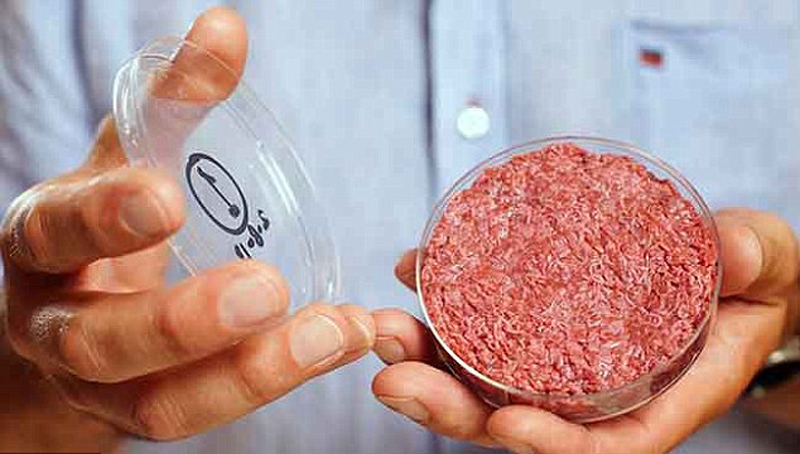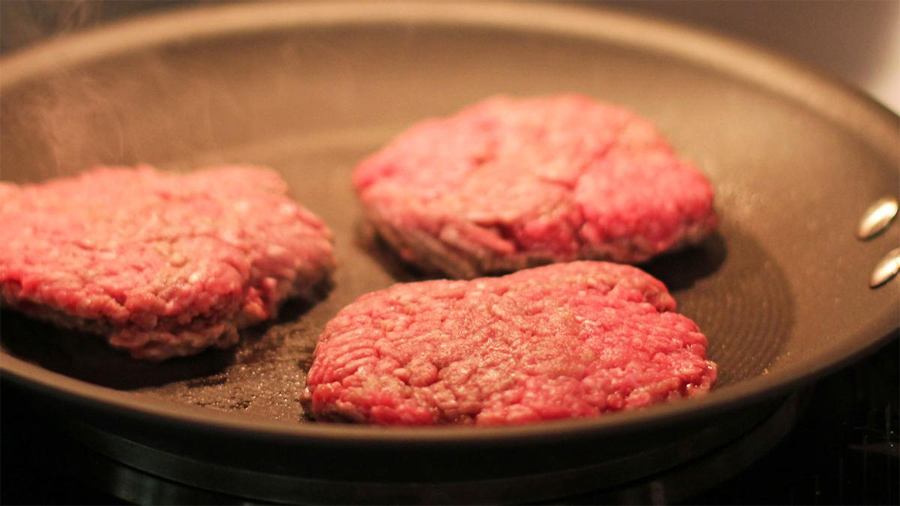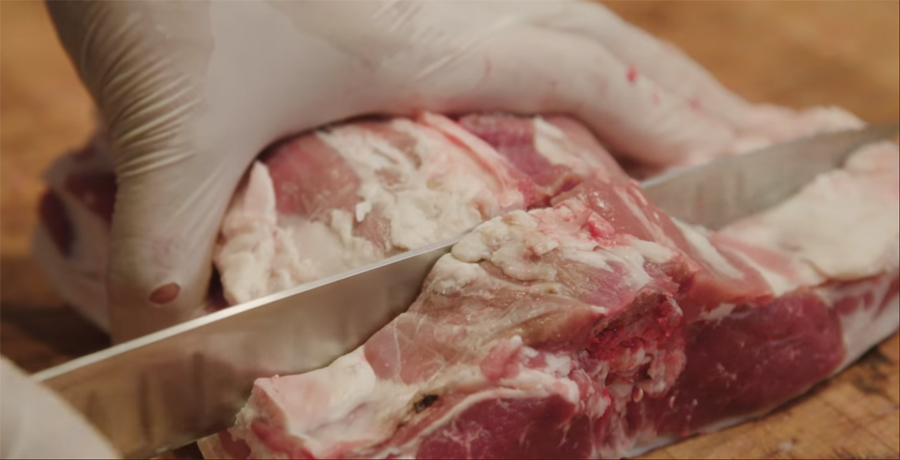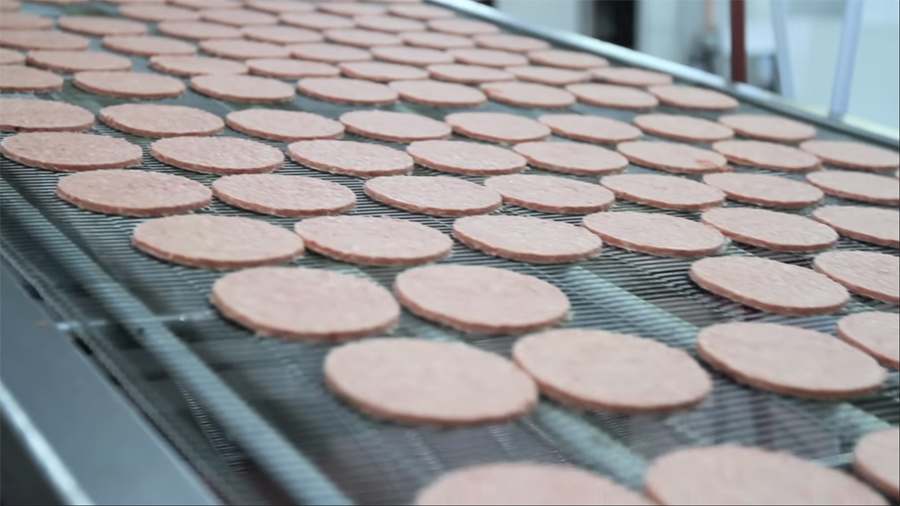Grown in laboratories, meat will be served in restaurants in California this year. By 2020, it will become cheaper than usual, and large fast food chains will start switching to it, and then it will go to supermarkets. This was stated by the company JUST, one of the leading developers of "test tube meat". Bill Gates, Sergey Brin, Richard Branson and many other investors in technology are counting on the same.
 Appetizing?
Appetizing?In 2008, the production in the laboratory of a piece of beef weighing 250 grams cost $ 1 million. In 2013, a burger grown in London for the experiment cost $ 325,000. Now its price has fallen to $ 11. In the next few years, artificial meat is guaranteed to be cheaper than natural. Why do we need it, how scientists grow Meat 2.0, what taste it has and why this technology will change our world.
What is wrong with the current meat?
Pork, beef, chicken. Delicious and natural foods we are used to. But, unfortunately, this cannot go on for long.
The first , main reason is global warming. One cow “releases” from 70 to 120 kg of methane per year. Methane is one of the greenhouse gases, as is carbon dioxide (CO 2 ). But its negative impact on climate is 23 times stronger. That is, 100 kg of methane from a cow is the equivalent of 2300 kg of carbon dioxide. This is about 1000 liters of gasoline. With a machine that consumes 8 liters per 100 km, you can drive 12,500 km every year, and only then will you equal in influence on the climate with one cow quietly chewing grass on the farm. In addition, there are much more cows and bulls in the world than cars. According to the latest estimates, 1.5 billion against 1.2 billion.

Of course, the total transport in the world contributes to global warming more than peaceful heifers. One container ship or cruise liner "soars" as 80-150 thousand cars. But the influence of livestock cannot be underestimated. For every 1 kg of beef in the store, the equivalent of 35 kg of carbon dioxide is emitted into the atmosphere. A kilogram of pork - 6.35 kg CO 2 , a kilogram of chicken - 4.57 kg CO 2 . It is now estimated that 18% of emissions affecting global warming come from pets. No matter how many plants switch to solar energy, no matter how many electric vehicles Ilon Mask produces, this factor remains with us.
The problem is that humanity continues to grow. Scientists estimate that by 2050 we will have 9.6 billion. Urbanization and the growth of the middle class will lead to an additional increase in the demand for meat. According to the Food and Agriculture Organization of the United Nations, the world will have to produce 70% more food. And they say that with current technology it is simply impossible.
 How much meat (and eggs) was consumed in 2005, and how much will be consumed in 2050
How much meat (and eggs) was consumed in 2005, and how much will be consumed in 2050One of those who hold such an opinion is Bill Gates. According to him, if we have more than 9 billion, it’s simply impossible to feed all people with natural meat. Over the past few years, he has invested in a dozen startups who grow meat in laboratories. Richard Branson and billionaires from Hong Kong, China and India followed suit. In his personal blog, in a note on the future of food in 2013, Gates wrote :
Growing animals for meat requires a lot of land and water, and seriously harms our planet. To put it bluntly, we are not able to feed more than nine billion people. And at the same time, we cannot ask everyone to become a vegetarian. Therefore, we must find options for meat production without depleting our resources.
The second reason (it was partially touched by Bill Gates) is that farms and pastures for animals take up a lot of space on the planet. Lots of. Under the content of livestock now allocated 30% of the entire dry surface of the Earth. Often these are pastures at the site of former forests. About 70% of the former Amazon forests are now cut down by animal grazing. And 33% of all arable land is grown feed for livestock. Space for people and nature is less.
The third reason is also unprofitable. Meat production is a wildly inefficient process. To make 1 kg of beef, you need to spend more than 38 kg of feed and almost 4 thousand liters of water (given the watering of corn and soybeans). Cows take 20 times more food than is needed to eliminate the problem of hunger on the planet. And if we become 9.6 billion, there will not be enough water for meat production (there is, of course, the option of desalination, but these are additional costs and other problems).

The meat grown in the laboratory now requires 100 times less land and 5.5 times less water than natural meat, despite the fact that the technology is not yet polished. According to the latest estimates by scientists from Oxford , if we can switch to it, it will reduce the "emissions" of greenhouse gases from livestock by 78-96%, reduce energy consumption by 7-45% and save 82% -96% of fresh water (such strong variations associated with different types of meat).
The fourth reason to switch to “test tube meat” is, of course, a decrease in the number of killings and suffering of animals. To some, this factor seems meaningless, but for someone it is the most important. The Organization for the Protection of Animal Rights (PETA) invests its money in the technology of growing nuggets and steaks. In 2014, she offered a $ 1 million reward to the first scientist who will market the chicken-grown lab:
We believe that this is the first important step in creating environmentally friendly, humanely produced real meat in the hands and mouths of those people who insist on eating the flesh of animals.
How to make meat in vitro
In fact, of course, cultivated or “pure” meat (as it is now being tried to be branded in the West) is grown not in a test tube, but in a Petri dish or a special container. There are dozens of companies with their own approaches, but in general the process is divided into three stages:
1. First, collect cells that are prone to rapid reproduction. These can be embryonic stem cells, adult stem cells, myosatellite cells, or myoblasts. At this stage, scientists need an animal (or perfectly preserved cells, but have not yet reached this).

2. Cells are treated by adding proteins that promote tissue growth. Then they are placed in the culture medium , in the bioreactor. It performs the role of blood vessels, supplying cells with everything necessary, and giving them conditions for growth. The main nutrient of cells is the blood plasma of an animal (most often the embryo). It adds a mixture of sugars, amino acids, vitamins and minerals. To properly develop muscle tissue, it is grown under pressure, simulating natural conditions. Heat and oxygen are also fed into the bioreactor. Essentially, cells do not even suspect that they grow outside the animal.

3. To make meat three-dimensional, but not flat, laboratories use peculiar "scaffolding". Ideally, they should also be edible, and periodically move, stretching the developing muscle tissue, imitating the movements of the real body. So far, they have not been concentrating at this stage, but everyone agrees that without him, the creation of any believable meat is impossible. Neither the consistency, nor the texture of the mass, quietly developing in the Petri dish, the modern consumer will not be deceived.

Completely free the animals from work, as we see, is not yet possible. Both at the first and at the second stage, elements from the real body are needed. But theoretically it will soon be possible to do without it. Stem cells - clone or grow separately, and blood plasma - to find a substitute. Scientists say that in ideal conditions for two months of cultivation of cultured meat can be obtained from 10 cells of the pig to get 50,000 tons of product.
But those who call this meat “pure” are slightly cunning. For its cultivation need preservatives, such as sodium benzoate , to protect the meat from the fungus. Also, collagen powder, xanthan, mannitol and so on are used at different stages. If you are worried that “animals on farms are stuffed with antibiotics and all kinds of chemicals,” with the advent of meat from the laboratories, your fears will increase.

However, according to the development companies, cultured meat has one advantage over the natural product. It may be useful for the waist. With some meat products, like steaks, fat is an important part of the texture and taste. Firms that grow muscle cells can control which type of fat will grow with their meat. They can only develop beneficial fats, like omega-3 unsaturated fatty acids, which improve heart function and speed up metabolism.
First goal is foie gras
There is one meal that is easy to compete with. Liver overfed goose or duck, one of the most expensive types of meat. For $ 50 per pound, more than $ 110 per kg! With such a price, the “test-tube” product already now seems to be a profitable alternative. Growing goose or duck liver in the laboratory is just as easy as growing chicken nuggets, and the profits are much greater.

Experiments with foie gras are now being conducted by JUST (formerly Hampton Creek). The goal is to start shipping it to American restaurants this year. The company has experience in launching successful products to the market. Her portfolio includes egg-free mayonnaise and chocolate chips, popular with vegans.
Animal rights activists have long opposed the methods that make foie gras. Goose and ducks on farms forcefully stuff a tube with food into the throat and feed them until they can walk. They disrupt the metabolic process, and the liver, trying to process all this, swells 10 times more than its normal size.
 Feeding on a farm that makes foie gras
Feeding on a farm that makes foie grasThe network is full of videos from activists who broke through on American farms and secretly shot the condition of animals there. Special noise was made by the footage of a rat eating a live goose from behind, because it is not able to protect itself (I don’t want to paint the details, those who wish to delve into the topic can still find videos on YouTube). After the scandal erupted, California banned the production and sale of foie gras on its territory. For local lovers of delicacy, laboratory foie gras will be a chance to legally buy a product without crossing the state borders. And supporters of the humane treatment of animals will be able to sleep peacefully. The JUST team needs only one goose donor, and the rats are definitely not allowed to go to it.
There is only one, little problem. Gourmets, willing to give any money for their foie gras, it is almost impossible to convince. They subtly distinguish taste (or, at least, they think so), and do not want to compromise. It’s easier for them to go to the black market or spend half a day traveling for their favorite cookies. And the fact that laboratory meat saves them a couple of hundred dollars is not a factor at all. JUST, MosaMeat and other laboratories say they don’t really count on these customers. It is more important for them that every new customer who decides to try foie gras, first goes to buy their product.
 Foie gras from the lab
Foie gras from the labAbout taste
The main difficulty is that the product from the laboratories should be exactly like the meat to which we are accustomed. This is evidenced by CEO of MosaMeat, Peter Verstate:
When they try a product, they should have the impression that it is meat. Not “it looks like meat” or “it looks like meat”, it just has to be meat. This is the main difficulty.
Roughly speaking, the effect of the " ominous valley " works here. You know, when in movies or games it is easier to accept something completely new, or something obviously false, than fine computer graphics of a man, done at 99%? We have learned very well to distinguish this 1%, because we are confronted with people's faces daily. An attempt to accurately reflect a real person can achieve the opposite effect - it will seem to us that this is some kind of scary robot or an alien who has put on human skin.

With artificial meat - the same story. Roughly speaking, if the taste is completely unfamiliar to you, the brain says, "Oh, this is something new." And if the taste is similar to 99%, but there is some difference, the brain has a different reaction - “I know what it is, but something is wrong with it.” We are sent a signal - poison, poison! Tasteless, I want to spit out, some may even feel sick. And if some people are sick of your food, this is a big problem.
 Laboratory meat
Laboratory meatOver the last 1% of "similarity" now and developers are fighting meat from the bioreactor. The main problem is texture. The meat that grew on the bones has muscles and fat in a specific consistency, which is very hard to repeat. Therefore, before the steak is grown a few more years. But burgers and nuggets are doing now, and there are no particular complaints to their taste
 This is still far away
This is still far awayIn May 2013, London made the first burger from cultured meat. It consisted of 20,000 thin stripes of muscle tissue and cost $ 325,000, which came from an anonymous philanthropist (later it turned out that it was Sergey Brin). After trying a burger, culinary expert Hanni Ruzler gave her assessment:
It has a very strong taste, even at the place of roasting. I know that there is no fat here, and it is not as juicy as I would like, but the taste is very intense, it hits the receptors. If we blindly assessed the taste, I would say that this product is closer to the meat than to the soybean copy.
Developments in 2018 to taste even more like natural meat. And the price they have is much more adequate - from $ 11.36 per kg (some companies still charge $ 1,000– $ 2,400 price tags, but their prices also go down quickly). Paul Shapiro, author of the best-selling "Clean Meat: How to Grow Meat without Animals, Will Revolution in Dinner and in the World," tried the latest laboratory versions of beef, chicken, fish, duck, foie gras and chorizo (Spanish pork sausages). According to him,
They taste just like meat, because it is meat.
But not everyone has such progressive views. In a 2014 study, 80% of Americans said they were not ready to eat meat grown in a laboratory. In 2017, only 30% said they were open to including such meat in their diet, and sometimes use it instead of the traditional one. Among those who are against all these “experiments of mad scientists”, the product even got a nickname. He is derogatoryly called "franken-meat".
 Looks like a real one?
Looks like a real one?Supporters of cultivated meat and the companies that develop it, consider that time is on their side. Paul Shapiro says:
Look at the examples of the story. Previously, ice was mined on the lake, and carried in massive chunks for sale. Now we get ice in the comfort of our kitchen. We call this the “freezer,” and we see nothing artificial in it. Ice cream, yogurt, beer, all this has changed thanks to technology. We must accept that it will be the same with meat. We have no other way.

PS Pochtoy.com delivers purchases from US stores. From $ 8.99 per pound. And if you register with us with the Geektimes code, you will be credited $ 7.